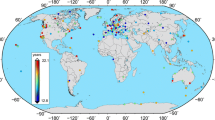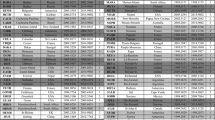Abstract
Twelve years of DORIS data from 31 selected sites of the IGN/JPL (Institut Géographique National/Jet Propulsion Laboratory) solution IGNWD05 have been analysed using maximum likelihood estimation (MLE) in an attempt to understand the nature of the noise in the weekly station coordinate time-series. Six alternative noise models in a total of 12 different combinations were used as possible descriptions of the noise. The six noise models can be divided into two natural groups, temporally uncorrelated (white) noise and temporally correlated (coloured) noise. The noise can be described as a combination of variable white noise and one of flicker, first-order Gauss–Markov or power-law noise. The data set as a whole is best described as a combination of variable white noise plus flicker noise. The variable white noise, which is white noise with variable amplitude that is a function of the weekly formal errors multiplied by an estimated scale factor, shows a dependence on site latitude and the number of DORIS-equipped satellites used in the solution. The latitude dependence is largest in the east component due to the near polar orbit of the SPOT satellites. The amplitude of the flicker noise is similar in all three components and equal to about 20 mm/year1/4. There appears to be no latitude dependence of the flicker noise amplitude. The uncertainty in rates (site velocities) after 12 years is just under 1 mm/year. These uncertainties are around 3–4 times larger than if only variable white noise had been assumed, i.e., no temporally correlated noise. A rate uncertainty of 1 mm/year after 12 years in the vertical is similar to that achieved using Global Positioning System (GPS) data but it takes DORIS twice as long to reach 1 mm/year than GPS in the horizontal. The analysis has also helped to identify sites with either anomalous noise characteristics or large noise amplitudes, and tested the validity of previously proposed discontinuities. In addition, several new offsets were found in the time-series that should be used or at least flagged in future work.
Similar content being viewed by others
References
Agnew D (1992) The time-domain behavior of power-law noises. Geophys Res Lett 19: 333–336
Allan DW (1966) Statistics of atomic frequency standards. Proc IEEE 54: 221–230
Altamimi Z, Sillard P, Boucher C (2002) ITRF2000, a new release of the international terrestrial reference frame for earth science applications. J Geophys Res 107(B10):2214 DOI 10.1029/2001JB000561
Altamimi Z, Boucher C, Willis P (2005) Terrestrial reference frame requirements within GGOS perspective. J Geodyn 40(4–5): 363–374. DOI 10.1016/j.jog.2005.06.002
Beavan J (2005) Noise properties of continuous GPS data from concrete-pillar geodetic monuments in New Zealand, and comparison with data from U.S. deep drilled braced monuments. J Geophys Res 110(B8): B08410. DOI 10.1029/2005JB003642
Beran J (1994) Statistics for long memory processes. Monogr. Stat. Appl. Probab., vol 61. Chapman and Hall, New York, 315 pp
Beutler G, Rothacher M, Schaer S, Springer TA, Kouba J, Neilan RE (1999) The International GPS Service (IGS): an interdisciplinary Service in support of earth sciences. Adv Space Res 23(4):631–635
Blewitt G, Lavallée D (2002) Effect of annual signals on geodetic velocity. J Geophys Res 107(B7):2145. DOI 10.1029/2001JB000570
Caporali A (2003) Average strain rate in the Italina crust inferred from a permanent GPS network I. Statistical analysis of the time series of permanent GPS stations. Geophys J Int 155(1):241–253
Cazenave A, Valette JJ, Boucher C (1992) Positioning results with DORIS on SPOT2 after first year of mission. J Geophys Res 97(B5):7109–7119
Crétaux JF, Soudarin L, Cazenave A, Bouille F (1998) Present-day tectonic pate motions and crustal deformations from the DORIS space system. J Geophys Res 103(B12):30167–30181
DeMets C, Gordon RG, Argus DF, Stein S (1990) Current plate motions. Geophys J Int 101(2):425–478
DeMets C, Gordon RG, Argus DF, Stein S (1994) Effect of recent revisions to the geomagnetic reversal time scale on estimates of current plate motions. Geophys Res Lett 21(20):2191–2194
Dong F, Fang P, Bock Y, Cheng MK, Miyazaki S (2002) Anatomy of apparent seasonal variations from GPS-derived site position time series. J Geophys Res 107(B4):2075. DOI 10.1029/2001JB000573
Eberhart-Phillips D, Haeussler PJ, Freymueller JT, Frankel AD, Rubin CM, Craw P, Ratchkovski NA, Anderson G, Carver GA, Crone AJ, Dawson TE, Fletcher H, Hansen R, Harp EL, Harris RA, Hill DP, Hreinsdóttir S, Jibson RW, Jones LM, Kayen R, Keefer DK, Larsen CF, Moran SC, Personius SF, Plafker G, Sherrod B, Sieh K, Sitar N, Wallace WK (2003) The 2002 Denali fault earthquake, Alaska: a large magnitude, slip-partitioned event. Science 300(5622):1113–1118
Fagard H (submitted) 20 years of evolution for the DORIS permanent network, from its initial deployment to its renovation. J Geod, DORIS Special Issue
Feissel-Vernier M (2005) IDS contributions to ITRF2004. http:// www.lareg.ensg.ign.fr/IDS/ITRF2004.html
Gelb A (ed) (1994) Applied optimal estimation. MIT Press, Cambridge, 374 pp
Hosking JRM (1981) Fractional differencing. Biometrika 68(1):165–176
Hreinsdóttir S, Freymueller JT, Fletcher HJ, Larsen CF, Bürgmann R (2003) Coseismic slip distribution of the 2002 Mw7.9 Denali fault earthquake, Alaska, determined from GPS measurements. Geophys Res Lett 30(13):1670. DOI 10.1029/2003GL017447
Johnson H, Agnew DC (2000) Correlated noise in geodetic time series. Tech Rep 1434-HQ-97-GR-03155, United States Geological Survey
Langbein J (2004) Noise in two-color electronic distance meter measurements revisited. J Geophys Res 109(B4):B04406. DOI 10.1029/2003JB002819
Langbein J, Bock Y (2004) High-rate real-time GPS network at Parkfield: utility for detecting fault slip and seismic displacements. Geophys Res Lett 31(15):L15S20. DOI 10.1029/2003GL019408
Langbein JO, Johnson H (1997) Correlated errors in geodetic time series: implications for time-dependent deformation. J Geophys Res 102(B1):591–603
Le Bail K (2004) Etude statistique de la stabilité des stations de géodésie spatiale. Application à DORIS. 10 Dec 2004. Thèse de doctorat en Dynamique des systèmes gravitationnels. Observatoire de Paris
Le Bail K, Feissel-Vernier M (2003) Time series statistics of the DORIS and GPS colocated observations. Geophys Res Abs 5 EAE03-A-04078, EGS-AGU-EUG Joint Assembly, Nice, France
Lefebvre M, Cazenave A, Escudier P, Biancale R, Crétaux JF, Soudarin L, Valette JJ (1996) Space tracking system improves accuracy of geodetic measurements. EOS Trans AGU 77(4):25, 28–29
MacMillan D, Cohen S (2004) Postseismic transient after the 2002 Denali Fault Earthquake from VLBI measurements at Fairbanks. In: Vandenberg N, Baver KD (eds) Proc IVS 2004 general meeting, NASA/CP-2004-212255, pp 491–495
Mandelbrot B, Van Ness J (1968) Fractional Brownian motions, fractional noises, and applications. SIAM Rev 10:422–439
Mao A, Harrison CGA, Dixon TH (1999) Noise in GPS coordinate time series. J Geophys Res 104(B2):2797–2816
Nikolaidis R (2002) Observation of geodetic and seismic deformation with the Global Positioning System. Ph.D. thesis, University of California, San Deigo
Noll C, Soudarin L (submitted) On-line resources supporting the data, products, and information infrastructure for the IDS. J Geod. DOI 10.1007/s00190-006-0051-y
Nothnagel A (2003) VTRF2003: a conventional VLBI terrestrial reference frame. In: Schwegmann W, Thorandt V (eds) Proceedings of the 16th working meeting on European VLBI for geodesy and astrometry, Leipzig, pp 195–205
Pearlman MR, Degnan JJ, Bosworth JM (2002) The International Laser Ranging Service. Adv Space Res 30(2):135–142
Penna NT, Stewart MP (2003) Aliased tidal signatures in continuous GPS height time series. Geophys Res Lett 30(23):2184. DOI 10.1029/2003GL018828
Prawirodirdjo L, Bock Y (2004) Instantaneous global plate motion model from 12 years of continuous GPS observations. J Geophys Res 109(B8):B08405. DOI 10.1029/2003JB002944
Press WH, Flannery BP, Teukolsky SA, Vetterling WT (1992) Numerical recipes. Cambridge University Press, New York, 818 pp
Scargle JD (1982) Studies in astronomical time series analysis, II. Statistical aspects of spectral analysis of unevenly spaced points. Astrophys J 263(2):835–853
Schlüter W, Himwich E, Nothnagel A, Vandenberg N, Whitney A (2002) IVS and its important role in the maintenance of the global reference systems. Adv Space Res 30(2):145–150
Schmidt L, Skinner J (2004) The Allan Variance as an estimator for the long-memory parameter: time-domain and wavelet methods. In: Proceedings of the 36th annual precise time and time interval (PTTI) systems and applications meeting, Washington, pp 455–464
Sillard P, Boucher C (2001) A review of algebraic constraints in terrestrial reference frame datum definition. J Geod. 75(2–3): 63–73. DOI 10.1007/s001900100166
Soudarin L, Cazenave A (1995) Large-scale tectonic plate motions measured with the DORIS space geodesy system. Geophys Res Lett 22(4):469–472
Soudarin L, Crétaux JF, Cazenave A (1999) Vertical crustal motions from the DORIS space-geodesy system. Geophys Res Lett 26(9):1207–1210
Stewart MP, Penna NT, Lichti DD (2005) Investigating the propagation mechanism of unmodelled systematic errors on coordinate time series estimated using least squares. J Geod. 79(8):479–489. DOI 10.1007/s00190-005-0478-6
Tapley BD, Bettadpur S, Ries JC, Thompson PF, Watkins MM (2004) GRACE measurements of mass variability in the Earth system. Science 305(5683):503–505
Tavernier G, Fagard H, Feissel-Vernier M, Lemoine F, Noll C, Ries J, Soudarin L, Willis P (2005) The International DORIS Service (IDS). Adv. Space Res 36(3):333–341. DOI 10.1016/j.asr.2005.03.102
Titov O, Tregoning P (2005) Effect of post-seismic deformation on earth orientation parameter estimates from VLBI observations: a case study at Gilcreek, Alaska. J Geod. 79(4–5):196–202. DOI 10.1007/s00190-005-0459-9
Webb F, Zumberge J (eds) (1995) An introduction to GIPSY/OASIS II. Rep. JPLM D-11088, Jet Propulsion Labaratory Pasadena
Williams SDP (2003a) The effect of coloured noise on the uncertainties of rates estimated from geodetic time series. J Geod. 76(9–10):483–494. DOI 10.1007/s00190-002-0283-4
Williams SDP (2003b) Offsets in global positioning system time series. J Geophys Res 108(B6):2310. DOI 10.1029/2002JB002156
Williams SDP, Bock Y, Fang P, Jamason P, Nikolaidis RM, Prawirodirdjo L, Miller M, Johnson DJ (2004a) Error analysis of continuous GPS position time series. J Geophys Res 109(B3):B03412. DOI 10.1029/2003JB002741
Williams SD, Agnew D, Wyatt F, Bock Y (2004b), Testing monument stability with short-baseline GPS measurements. In: EOS Trans AGU 85(47) Fall Meet Suppl, Abstract G51D-05
Willis P, Heflin MB (2004) External validation of the GRACE GGM01C gravity field using GPS and DORIS positioning results. Geophys Res Lett 31(13):L13616. DOI 10.1029/2004GL020038
Willis P, Ries JC (2005) Defining a DORIS core network for Jason-1 precise orbit determination based on ITRF2000: methods and realization. J Geod. 79(6–7):370–378. DOI 10.1007/s00190-005- 4075-9
Willis P, Haines B, Berthias JP, Sengenes P, Le Mouel JL (2004) Comportement de l’oscillateur DORIS/Jason au passage de l’anomalie sud-atlantique. Behavior of the DORIS/Jason oscillator over the South Antlantic Anomaly. CR Geosci 336(9):839–846. DOI 10.1016/j.crte.2004.01.004
Willis P, Boucher C, Fagard H, Altamimi Z (2005a) Applications geodesiques du systeme DORIS a l’IGN, Geodetic applications of the DORIS system at the French Institut Geographique National. CR Geosci 337(7):653–662. DOI 10.1016/j.crte.2005.03.002
Willis P, Bar-Sever YE, Tavernier G (2005b) DORIS as a potential part of a global geodetic observing system. J Geodyn 40(4–5):494–501. DOI 10.1016/j.jog.2005.06.011
Willis P, Berthias JP, Bar-Sever YE (2006) Systematic errors in Z-geocenter derived using satellite tracking data. A case study from SPOT-4 DORIS data in 1998. J Geod. 79(10–11):567–572. DOI 10.1007/s00190-005-0013-9
Zhang J, Bock Y, Johnson H, Fang P, Genrich JF, Williams S, Wdowinski S, Behr J (1997) Southern California Permanent GPS Geodetic Array: error analysis of daily position estimates and site velocities. J Geophys Res 102(B8):18035–18055
Zumberge JF, Heflin MB, Jefferson DC, Watkins MM, Webb FH (1997) Precise point positioning for the efficient and robust analysis of GPS data from large networks. J Geophys Res 102(B3):5005–5017
Author information
Authors and Affiliations
Corresponding author
Electronic supplementary material
Rights and permissions
About this article
Cite this article
Williams, S.D.P., Willis, P. Error Analysis of Weekly Station Coordinates in the DORIS Network. J Geodesy 80, 525–539 (2006). https://doi.org/10.1007/s00190-006-0056-6
Received:
Accepted:
Published:
Issue Date:
DOI: https://doi.org/10.1007/s00190-006-0056-6




